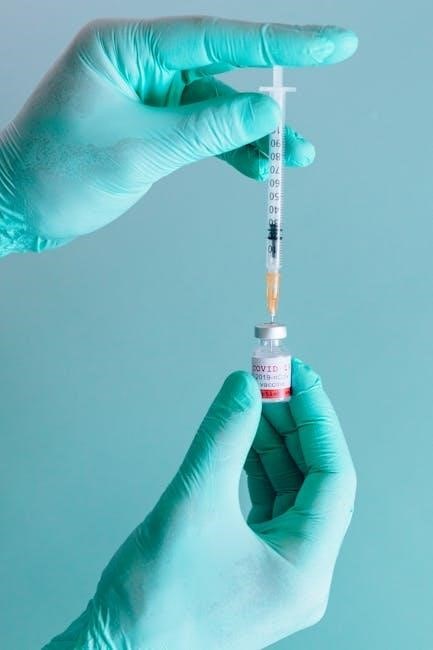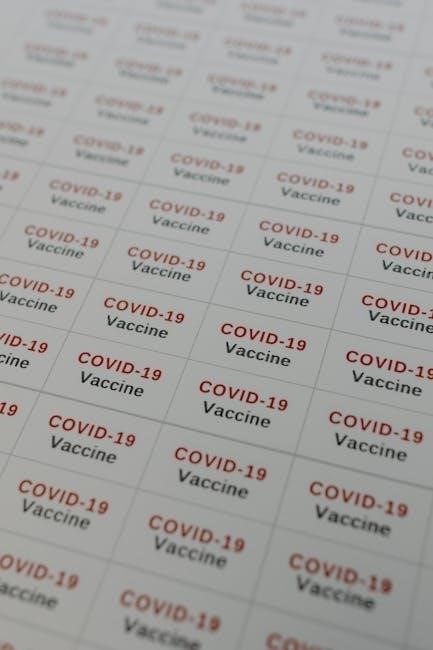
This seminal text, authored by Amy Jnah and Christopher McPherson, introduces core concepts in fetal and neonatal pharmacology, focusing on perinatal therapies and their implications for neonates.
1.1. Definition and Scope
Fetal and neonatal pharmacology focuses on the study of drug interactions and responses in fetuses and newborns, emphasizing developmental sensitivity. It encompasses pharmacokinetics, pharmacodynamics, and placental drug transfer mechanisms. This field addresses the unique physiological characteristics of fetuses and neonates, guiding safe and effective medication use. The scope includes understanding drug efficacy, safety, and dosing tailored to developmental stages. Advanced practice nurses play a crucial role in managing complex pharmacological needs, ensuring optimal outcomes for pregnant women and their newborns. This specialized area of pharmacology bridges maternal and neonatal care, highlighting the importance of precise drug administration.
1.2. Importance of Pharmacology in Fetal and Neonatal Care
Fetal and neonatal pharmacology is critical for optimizing maternal and newborn outcomes, addressing the unique physiological needs of these vulnerable populations. Medication administration in this context requires precise dosing and careful monitoring due to the immaturity of organ systems. Advanced practice nurses (APNs) play a pivotal role in managing complex pharmacological therapies, ensuring safety and efficacy. The field emphasizes understanding drug interactions, teratogenic effects, and age-related pharmacokinetic differences. Effective pharmacological interventions can prevent complications, reduce morbidity, and improve long-term health outcomes for fetuses and neonates, making pharmacology indispensable in perinatal and neonatal care.
1.3. Role of Advanced Practice Nurses (APNs)
Advanced Practice Nurses (APNs) are pivotal in managing the complex pharmacological needs of pregnant women and newborns. They are responsible for prescribing, administering, and monitoring medications, ensuring safety and efficacy. APNs must understand fetal and neonatal pharmacokinetics, potential drug interactions, and teratogenic risks. Their role involves educating families, collaborating with interprofessional teams, and advocating for evidence-based practices. APNs also address ethical and legal considerations in neonatal care, making them essential in optimizing maternal and neonatal health outcomes. Their expertise bridges the gap between pharmacological advancements and clinical practice, ensuring personalized and effective care for high-risk populations.
Core Concepts in Fetal and Neonatal Pharmacology
This text introduces foundational principles of fetal and neonatal pharmacology, emphasizing pharmacokinetics, pharmacodynamics, and placental drug transfer, tailored for APNs and nursing students.
2.1. Pharmacokinetics in the Fetus and Neonate
Pharmacokinetics in the fetus and neonate involves the absorption, distribution, metabolism, and excretion of drugs, which are significantly influenced by developmental physiology. Neonates and fetuses have unique physiological characteristics, such as immature renal function, altered drug absorption, and differences in plasma protein binding, impacting drug concentrations. For instance, the neonatal liver’s metabolic capacity is limited, affecting drug metabolism. Placental transfer also plays a role in fetal drug exposure. Understanding these pharmacokinetic principles is essential for advanced practice nurses to optimize drug dosing and minimize adverse effects in this vulnerable population. Tailoring therapies based on these factors ensures safer and more effective care.
2.2. Pharmacodynamics in the Fetus and Neonate
Pharmacodynamics in the fetus and neonate examines the effects of drugs on the body, focusing on receptor interactions and response variability. Neonates and fetuses exhibit unique pharmacodynamic responses due to immature receptor systems and developmental changes in target organ sensitivity. For example, the immaturity of the neonatal brain alters responses to sedatives and analgesics. Additionally, hormonal fluctuations during fetal development can influence drug efficacy and toxicity. Understanding these pharmacodynamic differences is critical for advanced practice nurses to develop targeted therapies that maximize therapeutic effects while minimizing adverse outcomes in this vulnerable population. This knowledge is essential for optimizing drug regimens and improving neonatal care.
2.3. Placental Drug Transfer
Placental drug transfer is a critical process influencing fetal exposure to maternal medications. The placenta facilitates the exchange of substances between the maternal and fetal circulations, with drugs crossing via passive diffusion, active transport, or facilitated diffusion. Lipid-soluble, low-molecular-weight drugs readily cross the placenta, while large molecules and ionized drugs are less efficiently transferred. Maternal factors, such as blood flow and protein binding, and fetal factors, like metabolism, also affect drug transfer. Understanding these mechanisms is vital for managing fetal drug exposure and ensuring therapeutic efficacy while minimizing risks to the developing fetus. This knowledge guides advanced practice nurses in optimizing maternal and fetal outcomes.
Developmental Considerations
Developmental considerations in fetal and neonatal pharmacology involve physiological changes and pharmacokinetic differences, crucial for safe and effective drug administration in optimal neonatal care.
3.1. Fetal Development and Drug Response
Fetal development significantly influences drug response, as maturing organs and evolving metabolic pathways affect pharmacokinetics. The placenta plays a key role in drug transfer, impacting fetal exposure. Understanding these dynamics is crucial for safe and effective therapy, as improper drug administration can lead to complications. This section explores how fetal development stages, from embryogenesis to birth, influence drug efficacy and toxicity, providing APNs with essential insights to tailor treatments for pregnant women and their fetuses, ensuring optimal outcomes while minimizing risks. Advanced practice nurses must consider these factors to deliver evidence-based, individualized care.
3.2. Neonatal Development and Drug Metabolism
Neonatal development significantly impacts drug metabolism due to the immaturity of organs like the liver and kidneys, which affect drug clearance. Age-related differences in enzyme activity and renal function influence pharmacokinetics, necessitating tailored dosing strategies. Premature infants are particularly vulnerable due to underdeveloped metabolic pathways, requiring careful monitoring. Advanced practice nurses must account for these physiological variations to optimize drug efficacy and safety. Understanding neonatal developmental stages is critical for managing medications effectively, ensuring therapeutic outcomes while minimizing adverse effects. This section provides insights into how neonatal development shapes drug metabolism, guiding APNs in evidence-based clinical decision-making for newborn care.
3.3. Age-Related Differences in Drug Action
Age significantly influences drug action in neonates and infants due to differences in receptor sensitivity and drug target expression. Neonates exhibit unique physiological characteristics, such as immature organ systems, affecting drug response. As infants grow, receptor maturation and changes in body composition alter drug efficacy and toxicity. Advanced practice nurses must consider these age-related variations to ensure safe and effective drug administration. Understanding how developmental stages impact drug action is crucial for optimizing therapeutic outcomes and minimizing adverse effects in this vulnerable population. This section highlights key principles guiding age-specific pharmacotherapy in neonatal and infant care.

Maternal-Fetal Medicine
This section explores drug therapy during pregnancy, teratogenicity, and maternal-fetal drug transfer, emphasizing safety and efficacy for both mother and fetus, guided by expert resources like Jnah’s textbook.
4.1. Drug Therapy During Pregnancy
Drug therapy during pregnancy requires careful consideration of fetal and maternal health. Advanced practice nurses (APNs) must balance therapeutic benefits with potential fetal risks. Factors such as pharmacokinetic changes, teratogenicity, and placental drug transfer are critical. The book by Amy Jnah and Christopher McPherson provides guidance on safe medication use, emphasizing dosing adjustments and monitoring. It addresses challenges in managing conditions like neonatal sepsis and highlights interprofessional collaboration for optimal outcomes. This section serves as a practical guide for APNs, ensuring informed decision-making to protect both mother and fetus while maintaining therapeutic efficacy.
4.2. Teratogenicity and Drug Safety
Teratogenicity refers to the potential of drugs to cause fetal abnormalities during pregnancy. Advanced Practice Nurses (APNs) play a critical role in assessing risks and ensuring drug safety for both mother and fetus. The book by Amy Jnah and Christopher McPherson provides comprehensive guidance on identifying teratogenic agents and minimizing risks; Understanding pharmacokinetic and pharmacodynamic changes in pregnancy is essential for modifying drug dosages. APNs must collaborate with pharmacists and obstetricians to monitor fetal development and ensure safer medication use, balancing therapeutic benefits with potential fetal harm to optimize outcomes.
4;3. Maternal-Fetal Drug Transfer Mechanisms
Maternal-fetal drug transfer primarily occurs via the placenta, with mechanisms including passive diffusion, active transport, and facilitated diffusion. Lipid-soluble drugs cross more easily, while large molecules are restricted. Placental metabolism can alter drug concentrations. Advanced Practice Nurses (APNs) must understand these mechanisms to optimize therapeutic outcomes and minimize risks. Factors like gestational age and placental health influence transfer efficiency. Collaboration with pharmacists ensures appropriate dosing and monitoring, balancing fetal exposure with maternal health needs. This knowledge is vital for safe medication management during pregnancy, as outlined in the textbook by Amy Jnah and Christopher McPherson.

Therapeutic Drug Monitoring in Neonates
Therapeutic drug monitoring in neonates ensures optimal drug levels, balancing efficacy and safety. Advanced Practice Nurses (APNs) manage and interpret drug levels, adjusting treatments precisely to meet neonatal needs.
5.1. Indications for Drug Monitoring
Drug monitoring in neonates is critical for premature infants, critically ill patients, and those with renal or hepatic impairment. It ensures therapeutic drug levels, minimizing toxicity and optimizing efficacy. Advanced Practice Nurses (APNs) prioritize monitoring for drugs with narrow therapeutic indexes, such as aminoglycosides and vancomycin. Monitoring is also indicated for medications with significant pharmacokinetic variability, such as anticonvulsants and antibiotics. Neonates requiring long-term therapy or those at risk of drug accumulation benefit from regular monitoring. This practice ensures personalized care, improving outcomes and reducing adverse effects in vulnerable populations.
5.2. Methods of Drug Monitoring
Therapeutic drug monitoring (TDM) involves measuring serum drug concentrations to optimize dosing regimens. For neonates, blood samples are collected at specific intervals to assess peak and trough levels, ensuring efficacy and safety. Advanced Practice Nurses (APNs) use pharmacokinetic modeling to predict drug behavior in neonates with varying renal and hepatic functions. Additionally, clinical assessments, such as monitoring for signs of toxicity or therapeutic effects, guide adjustments. Regular monitoring of renal function and drug levels is crucial, especially for medications like aminoglycosides and vancomycin, to prevent toxicity and ensure therapeutic efficacy in this vulnerable population.
5.3. Interpretation of Drug Levels
Interpreting drug levels requires integrating pharmacokinetic data with clinical findings. Advanced Practice Nurses (APNs) assess whether serum concentrations fall within therapeutic ranges, balancing efficacy and toxicity. Neonatal factors, such as weight, gestational age, and organ maturity, guide dose adjustments. For drugs like aminoglycosides, target trough levels below 2 mg/L prevent nephrotoxicity, while maintaining peak levels above 5 mg/L ensures effectiveness. APNs collaborate with pharmacists to tailor regimens, ensuring safe and optimal therapy for neonates with unique physiological profiles.

Neonatal Abstinence Syndrome (NAS)
NAS occurs in neonates exposed to substances in utero, causing withdrawal symptoms. APNs play a critical role in assessing and managing this condition to improve outcomes.
6.1. Pathophysiology of NAS
NAS arises from in-utero exposure to substances, leading to fetal dependence; After birth, withdrawal occurs due to abrupt drug discontinuation. Symptoms reflect neurological, gastrointestinal, and respiratory distress. The pathophysiology involves altered neurotransmitter activity and receptor adaptation. Prolonged maternal substance use disrupts normal fetal development, causing physiological dependence. Postnatal withdrawal is exacerbated by immature neonatal regulatory systems. Factors like substance type, exposure duration, and maternal dosage influence severity. Advanced practice nurses play a critical role in early identification and targeted interventions to mitigate long-term developmental impacts. Understanding NAS pathophysiology is essential for effective, evidence-based care in neonatal settings.
6.2. Diagnosis and Assessment
Diagnosis of NAS involves clinical evaluation of withdrawal symptoms, often using standardized tools like the Finnegan Neonatal Abstinence Scoring Tool. Signs include tremors, irritability, excessive crying, and feeding difficulties. Assessment focuses on identifying the severity of symptoms, which guides therapeutic interventions. Timing of evaluation is critical, typically within the first few days of life. Advanced practice nurses play a pivotal role in early identification and monitoring. Accurate assessment ensures personalized care plans, optimizing outcomes for affected neonates and supporting their transition to health. Prompt recognition and systematic evaluation are essential for managing NAS effectively.
6.3. Pharmacologic Management
Pharmacologic management of NAS focuses on minimizing withdrawal symptoms and supporting neonatal comfort. Opioids, such as morphine or methadone, are commonly used to alleviate symptoms, with dosages carefully titrated based on the neonate’s response. Non-pharmacologic strategies, including swaddling, environmental modifications, and kangaroo care, complement medication therapy. Advanced practice nurses play a crucial role in prescribing and monitoring these interventions, ensuring safety and efficacy. The goal is to gradually wean the neonate off medications while managing discomfort and promoting developmental stability. Personalized care plans are essential to address individual needs and optimize long-term outcomes for affected infants.
Clinical Applications of Fetal and Neonatal Pharmacology
Clinical applications focus on optimizing drug therapies for neonates, including antibiotics for sepsis and analgesics for pain management, tailored to their developmental physiology and pharmacokinetic profiles.
7.1. Antibiotic Use in Neonates
Antibiotic use in neonates requires precise selection and dosing based on their unique pharmacokinetic profiles. Neonatal sepsis, a critical condition, necessitates timely and appropriate antibiotic therapy. Factors such as gestational age, weight, and renal maturity influence drug metabolism. Common pathogens, including Group B Streptococcus and E. coli, guide antibiotic choices. Dosage adjustments are essential to optimize therapeutic efficacy while minimizing risks of toxicity or resistance. Advanced practice nurses play a pivotal role in monitoring treatment response and ensuring safe, effective antibiotic regimens tailored to each neonate’s needs.

7.2. Analgesics and Sedatives in Neonatal Care
Analgesics and sedatives are crucial in neonatal care to manage pain and discomfort, ensuring the well-being of vulnerable patients. The use of these medications requires a deep understanding of neonatal pharmacokinetics, as immature organ systems significantly affect drug metabolism. Factors such as gestational age, weight, and renal function must be considered to optimize dosing regimens and minimize adverse effects. Commonly used agents include morphine and fentanyl, which are carefully titrated to achieve desired therapeutic outcomes. Advanced practice nurses play a vital role in assessing pain, monitoring for sedation-related complications, and adjusting medications to ensure safety and efficacy. Effective pain management enhances neonatal outcomes and supports developmental care.
7.3. Anticonvulsants and Neuroprotective Agents
Anticonvulsants and neuroprotective agents are essential in managing seizures and preventing neurological damage in neonates. Medications like magnesium sulfate are used to prevent seizures in at-risk newborns, while phenobarbital remains a first-line treatment for neonatal seizures; The pharmacokinetics of these drugs vary in neonates due to immature hepatic and renal systems, necessitating careful dosing. Advanced practice nurses must monitor for adverse effects, such as sedation or respiratory depression. Additionally, neuroprotective strategies, including hypothermia, are employed to mitigate brain injury. These interventions require a collaborative approach to optimize outcomes and safeguard the developing brain.

Interprofessional Collaboration

Effective teamwork among healthcare professionals is crucial in fetal and neonatal care, ensuring optimal pharmacological management and patient outcomes through shared expertise and coordinated decision-making.
8.1. Role of the Neonatal Nurse Practitioner (NNP)
Neonatal Nurse Practitioners (NNPs) play a vital role in managing the pharmacological needs of newborns, particularly those requiring intensive care. They assess neonatal patients, develop individualized care plans, and prescribe medications tailored to the infant’s developmental stage. NNPs must possess a deep understanding of pharmacokinetics and pharmacodynamics in neonates, as drug behavior varies significantly in this population. Their expertise ensures safe and effective medication administration, optimizing outcomes. Collaborating with other healthcare providers, NNPs also educate families on medication use and safety, bridging the gap between complex pharmacological therapies and practical, patient-centered care.
8.2. Collaboration with Pharmacists
Collaboration with pharmacists is essential in fetal and neonatal pharmacology, as they provide expertise in medication safety, dosing, and drug interactions. Pharmacists play a key role in ensuring appropriate therapeutic drug monitoring and interpreting pharmacokinetic data. Their input is crucial for optimizing drug regimens in neonates, where developmental changes significantly impact drug metabolism. By working together, advanced practice nurses and pharmacists can develop evidence-based guidelines tailored to the unique needs of neonatal patients. This interprofessional approach enhances medication safety and improves clinical outcomes, addressing the complex pharmacological challenges in neonatal care.
8.3. Communication with Pediatricians and Obstetricians
Effective communication between advanced practice nurses (APNs), pediatricians, and obstetricians is critical in fetal and neonatal pharmacology. This collaboration ensures seamless care coordination, particularly during transitions from prenatal to postnatal periods. APNs must communicate medication plans, potential drug interactions, and monitoring strategies clearly. Pediatricians provide insights into neonatal physiology and long-term developmental impacts, while obstetricians contribute to maternal-fetal considerations. This interdisciplinary dialogue ensures safe and effective medication use, addressing both maternal and neonatal needs. Clear communication fosters a unified approach, optimizing therapeutic outcomes and minimizing risks in this vulnerable population.
Legal and Ethical Considerations
APNs must navigate legal and ethical challenges in fetal and neonatal pharmacology, ensuring informed consent, privacy, and adherence to ethical guidelines in drug administration and care.
9.1. Informed Consent and Neonatal Care
Informed consent is a cornerstone of ethical neonatal care, ensuring parents or guardians understand treatment risks and benefits. Advanced Practice Nurses (APNs) play a vital role in providing clear, unbiased information to facilitate decision-making. This process respects patient autonomy and legal requirements, particularly in complex pharmacological interventions. Ensuring comprehension and addressing concerns fosters trust between families and healthcare providers. Informed consent must be tailored to the neonate’s unique needs, reflecting current pharmacological evidence and guidelines. This ethical practice upholds transparency and ensures that care aligns with familial values and medical best practices, safeguarding both the newborn and their family.
9.2. Ethical Dilemmas in Fetal and Neonatal Pharmacology
Ethical dilemmas in fetal and neonatal pharmacology often arise from balancing benefits and risks, particularly when medications impact vulnerable populations. Advanced Practice Nurses (APNs) face challenges such as drug safety during pregnancy, dosing accuracy in neonates, and long-term outcomes of early exposures. Patient autonomy and justice in resource allocation further complicate decision-making. These dilemmas require a deep understanding of pharmacokinetics, pharmacodynamics, and developmental physiology. Interprofessional collaboration is essential to navigate these complex situations, ensuring ethical care that prioritizes the well-being of both the fetus and neonate while respecting familial and societal values.
9.3. Legal Implications of Drug Administration
Legal implications in fetal and neonatal pharmacology involve adherence to drug laws, licensing, and off-label use guidelines. Advanced Practice Nurses (APNs) must ensure informed consent, proper documentation, and compliance with regulations. Liability arises from adverse drug reactions or dosing errors, emphasizing the need for precise pharmacokinetic knowledge. Legal standards require APNs to stay updated on evidence-based practices and drug approvals. Non-compliance can lead to malpractice claims, highlighting the importance of interprofessional collaboration and robust documentation to safeguard both patients and practitioners. Understanding these legal frameworks is crucial for safe and ethical drug administration in vulnerable populations.

Resources for Advanced Practice Nurses
Amy Jnah’s eBook, Fetal and Neonatal Pharmacology for the Advanced Practice Nurse, is a key resource, offering comprehensive guidance. Additional resources include professional guidelines, online databases, and networking opportunities tailored for APNs.
10.1. Recommended Textbooks and Guidelines
Amy Jnah’s Fetal and Neonatal Pharmacology for the Advanced Practice Nurse is a cornerstone resource, offering comprehensive guidance on pharmacologic therapies. Authored by Jnah and McPherson, it provides systematic approaches to drug administration. The eBook is available in PDF, EPUB, and Kindle formats, making it accessible for various learners. Professional guidelines from organizations like the American Academy of Pediatrics (AAP) and the National Institute for Child Health and Human Development (NICHD) are also essential. These resources ensure evidence-based practices, addressing developmental pharmacokinetics and teratogenic risks. They are indispensable for APNs managing complex neonatal and fetal care scenarios.
10.2. Online Resources and Databases
Online resources like PubMed and ClinicalTrials.gov provide access to the latest research on fetal and neonatal pharmacology. The Fetal and Neonatal Pharmacology for the Advanced Practice Nurse eBook, available in PDF format, is a key resource. Professional databases such as the FDA’s drug safety updates and the National Library of Medicine’s (NLM) resources offer critical information on teratogenicity and pharmacokinetics. These platforms enable APNs to stay updated on evidence-based practices, ensuring safe and effective medication management for neonates and pregnant women. They also support interprofessional collaboration by providing accessible, credible information.
10.3. Professional Organizations and Networking
Professional organizations like the National Association of Neonatal Nurses (NANN) and the National Association of Nurse Practitioners in Women’s Health (NPWH) provide networking opportunities and resources for APNs. These organizations offer access to evidence-based guidelines, educational webinars, and forums for collaboration. Networking with peers and experts through conferences and online platforms fosters shared knowledge and best practices in fetal and neonatal pharmacology. Membership in these groups also supports professional development and staying updated on the latest research and clinical advancements, ensuring APNs deliver optimal care for neonates and pregnant women.

This text serves as a vital resource for APNs, addressing core pharmacologic concepts and fostering interprofessional collaboration to enhance fetal and neonatal care outcomes.
11.1. Summary of Key Concepts

This text provides a comprehensive overview of fetal and neonatal pharmacology, emphasizing core pharmacologic concepts, developmental physiology, and interprofessional collaboration. It addresses the complex pharmacological needs of pregnant women and neonates, focusing on drug therapies, pharmacokinetics, and pharmacodynamics. The book highlights the role of advanced practice nurses (APNs) in managing medications for high-risk populations, ensuring safe and effective outcomes. By integrating clinical guidelines and practical applications, it serves as an essential resource for APNs, fostering a deeper understanding of fetal and neonatal care and promoting evidence-based practice in this specialized field.
11.2. Future Directions in Fetal and Neonatal Pharmacology
Future advancements in fetal and neonatal pharmacology will focus on personalized medicine, leveraging genetic and physiological data to tailor drug therapies. Research will prioritize drug safety, efficacy, and dosing regimens specific to neonatal populations. Innovations in drug delivery systems and biomarkers for therapeutic monitoring are anticipated. Interprofessional collaboration will remain crucial, with APNs playing a central role in translating research into clinical practice. Continued education and evidence-based guidelines will ensure optimal care for high-risk pregnancies and neonates, addressing unmet needs and improving outcomes in this vulnerable population.